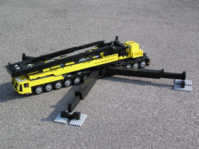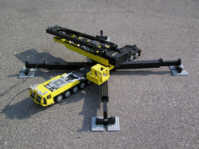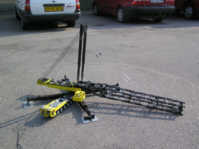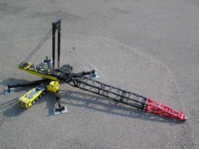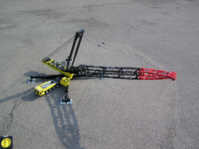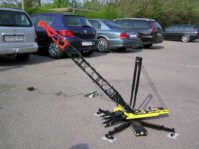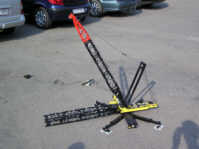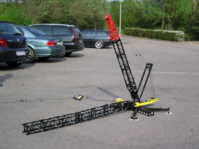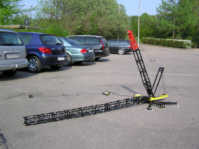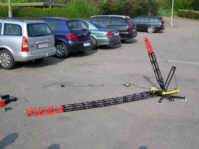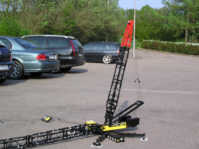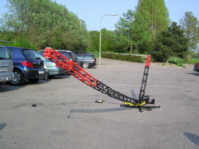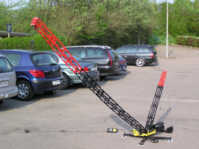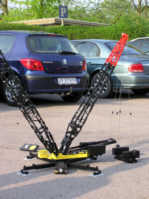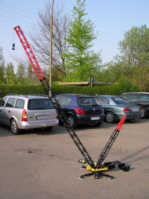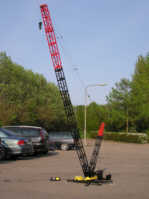Main Boom 3.30m, Superlift 1.20m
On this site the crane is showed in its second edition, equipped with a main boom of 3.30 meters and a
superlift of 1.20 meter.
Preparation
After I constructed the first version of the crane in a simple version, called S-configuration of 2.60 meters
I tried to make a Superlift with ballast. With this, the main boom is extended to 3.30 meters, which compared to real
scale is around 100 meters. One day when the weather was good, I took the crane outside to make some nice pictures,
the result is shown below. Regrettably 'my' parking place was filled with cars, so the reader has to deal with some
cars in the pictures. The cars are due to a local party, and there will be spectators and shadows from them in the
pictures. As usually the wind came up when the crane was raised, and therefore it was quickly taken down again.
Like a real crane, all of the parts has to be brought to the place where the lift is going to take place. In my
case I had to carry all the parts outside, make sure the light was good and plenty of room to make some good pictures.
The time went fast, and it almost took an hour before the first pictures were taken.
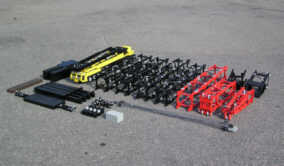 The parts for this setup are:
The parts for this setup are:
Chassis with superstructure and A-bracket.
4 outriggers.
4 pad jacks.
8 pad jack boards.
4 counterweights of 1450g each.
1 counterweight of 2500g.
1 support for maxi-lift ballast.
1 bottompart of Superlift.
1 bottompart of main boom.
1 extension for superlift, black.
4 extensions for main boom, 3 black and one red.
1 toppiece of Superlift.
1 toppiece of main boom.
10 quy pins.
1 lifting hook.
Assembly
Like the assembly of a single main boom, you first have to mount the 4 outriggers, pad jacks and pad jack boards
are set in place to give the crane the necessary stability. When the crane is going to lift something high up
in the air, it is very important that the chassis is absolutely horizontal. In this case the asphalt was almost horisontal
and I tried to raise the crane without an extra plate to place the crane on. But if the cranes should have been
higher, it would have been necessary to put it on an horisontal plate.
When the crane is assemblied with a superlift, it is almost doned in the same way as the simple main boom.
First the A-bracket is raised to a little above vertical position, and an assistant crane helps with the assembling of the single
parts of the superlift.
First the bottompart of the superlift is mount on the crane, thereafter an extension of 60 cm, which is compared to 18 meters. Thereafter
the toppiece of the superlift. In between the end of the A-bracket and the top of the superlift the quy-pins is mount.
Some quy-pins for the maxi-lift ballast are also attached to the top of the Superlift before it is raised up in the air.
The top of the superlift is red, to make it more visible for airplanes.
Then the superlift is raised by pulling the A-bracket down again.
When the Superlift is assemblied and raised a little, the assembly of the main boom can take place.
First part of the main boom is the bottompart, thereafter 3 black extensions of 60 cm, which corrosponds to 18 meters each.
Then a red extension of 60 cm, the reason for using a red sections in the top of the crane is to make it more
visible to airplanes. At last the toppiece with all the rollers for the lifting wire is mount.
When the whole boom is fitted, the quy-pins is attached between the top of the main boom, and half the way to the top
of the Superlift, the last half part is made with two blocks and a lot of wires.
When the main boom and superlift is in place, it is time to raise the Superlift to its working position, when the
superlift is pulled backwards the wires for the main boom is lowered, thereby the superlift can be luffed to a backwards
position without dropping down.
When the superlift is in this backward position the support for the maxi-lift ballast and the superstructure-ballast can be attached.
On this model I use two counterweights of 1450 g and on piece of metal of 2500 g, total 5,4 kg. On the superstructure is put two
counterweights of 1450 g. That means total 8.3 kg.
Then the main boom is raised a little from ground and the lifting hook is attached.
Below I have put a series of pictures which descripes the assembly.
Raise of the main boom
Now the main boom is ready to be raised to its working position, this is done by pulling the wires between the
top of the superlift and the top of the main boom.
As seen on the pictures it is clear that the load on the vertical boom is very large. It is about the maximum length
of a LEGO construction with these dimensions. When the boom is raised the pressure is lowered and the boom straightens out.
There were a very calm wind that day, but when the crane reaches its maximum of 3.30 meteres the force was big enough
to make the crane dangle in the wind. But I was lucky the crane did not crash and it could be carried home in one piece, to
be ready for new challenges.

| Max capacity |
Not tested |

| Max height |
3.30 m |

| Weight (without counterweight) |
6.1 kg |

| Counterweight |
8.3 kg |
|
|
 The parts for this setup are:
The parts for this setup are: